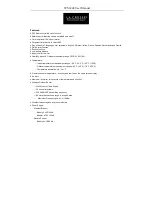
FINAL CHECKS / INSPECTION
Tech Support:
consumer.steppir.com/support | 425.453.1910 | [email protected]
65
•
Use locking wire on all turnbuckles to prevent them from loosening due to vibrations once the antenna is in the air.
•
Do a final check that all bolts are torqued down to the proper spec.
•
Check that all control cables and coax jumpers have proper strain relief at both ends and that there are no pinch
points where cables would be compressed when the antenna is lifted.
•
If you are lifting the control cable with the antenna, make sure that there is proper strain relief for the 24 conductor
control cable at the connector junction box.
•
Ensure all coax jumper connections are properly waterproofed with silicone tape or coax seal.
STANDARD OPERATING PROCEDURE
—SWR TESTS
Ground SWR Test
At this point it is helpful to do an SWR test to confirm that the elements and switching are still working properly. Even
though the SWR will be high because the antenna is close to the ground and has not been tuned yet, the test will still
reveal any major mechanical or electrical issues.
Step 1:
Connect the controller to the antenna and connect an SWR analyzer to the feedline.
No fault codes should
appear on the controller! If
“
check fault
” appears in the top right corner of the display go to the fault code menu
to diagnose the issue. Correct the issue before continuing with the installation. Contact [email protected]
for help
Step 2:
Print the
Ground SWR Results
table on the following page. Tune the antenna to the frequencies listed and rec-
ord the SWR, the resonant frequency and minimum SWR using an antenna analyzer. When finished, snap a picture of
the results and send it to [email protected].
Step 3:
Analyze the results, SWR < 3:1 is OK and can be tuned to 1.5:1 or less once the antenna is in the air. SWR >
3:1 indicates an issue with the wiring, controller, or motors. Address the cause of the high SWR (Contact sup-
[email protected] for help) and then repeat the SWR test.
Initial Tune SWR Test
Once the antenna has been raised onto the tower, an initial tune must be performed to optimize the antenna for mini-
mum SWR. Familiarize yourself with the antenna controller by reading the controller manual, particularly the section de-
scribing the Create/Modify function.
Step 1:
Connect the controller to the antenna and connect an SWR analyzer to the feedline.
No fault codes should
appear on the controller! If
“
check fault
” appears in the top right corner of the display go to the fault code menu
to diagnose the issue. Correct the issue before continuing with the installation. Contact [email protected]
for help
Step 2:
Print the
Initial Tune SWR Results
page and tune the antenna to the frequencies listed. Enter create/modify
mode on the controller to begin the tuning process.
Step 3:
For each frequency: record the initial SWR, resonant frequency, and minimum SWR. If the initial SWR is above
the acceptable limit, apply a band correction factor to adjust the antenna until the SWR is reduced to the desired level.
Note the band correction factor and SWR after tuning. Tune to the next frequency and repeat until the table has been
filled out.
Step 4:
When finished, snap a picture of the results and send it to [email protected].


































